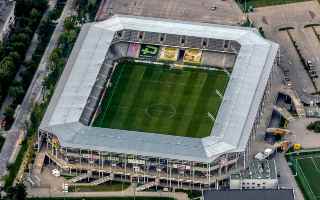Exbud Arena
| Capacity | 15 700 |
|---|---|
| 1020 ("Mlyn" section) | |
| 777 (Away fans section) | |
| 545 (Sector para familias) | |
| 320 (Sector de la "Tarjeta de entrada gratuita") | |
| 320 (Youth teams' section) | |
| 104 (VIP section) | |
| 54 (Press seats) | |
| Country | Poland |
| City | Kielce |
| Clubs | Korona Kielce SA |
| Other names | Kolporter Arena (2014–2018), Suzuki Arena (2018–2024), Sciegiennego (nickname) |
| Floodlights | 1,989 lux |
| Inauguration | 01/04/2006 (Korona Kielce – Zagłębie Lubin, 1–1) |
| Renovations | 2016 |
| Record attendance | 15,500 (Korona Kielce – Legia Warsaw, 3–1, 23/09/2006) |
| Design | ATJ Architekci |
| Cost | PLN 48 M |
| Construction time | 22/11/2004 – 01/04/2006 |
| Address | ul. Ściegiennego 6, Kielce |
| Other | under-soil heating |
Advertisement
Exbud Arena – stadium description
The stadium at one of Kielce's main arteries dates back to 1930's, though nothing is left of that historic ground. It, despite efforts to upgrade its standard in 1980s and 90s, fell into disrepair and was left significantly below requirements. Together with rapid growth of Korona, this prompted the decision of building a brand new stadium.
Groundbreaking took place in November of 2004 and by April 2006 the stadium was ready for its first ever game, played between Korona and Zagłębie Lubin. Official opening saw the famous Borussia Dortmund arrive for a friendly and return defeated 4:1.
It's widely considered to be the very first modern stadium to be opened in Poland and it thus soon attracted nationwide attention. Just a few months after opening the very first game came as part of the Euro 2008 qualifying campaign. It soon saw a record-breaking 10:0 against San Marino with Poland's fastest ever goal (23rd second). In 2012 the building hosted its first Polish Cup final between Legia and Ruch Chorzów. First ever sell-out crowd came, to no surprise, during the first game against Legia Warszawa in September of 2006.
Due to spatial constraints of the site, the stadium has some quirks. First, the main stand is in the east rather than west. Second, the stands are double-tiered despite limited capacity, in order to minimise the blueprint. Third, the roof is elevated in order to find a common ground between floodlight requirements and local height limit. With no tall individual masts allowed, the raised roof serves as basis for the lighting. This spares nearby residents the excess in lighting pollution, while sound insulation in the west mitigates matchday roar.
First international football event came rather late, when Poland hosted Euro 2017 (U21) and Kielce was one of 6 host cities. On that occasion the VIP zone, lighting and giant screens were improved. Starting in 2014 the stadium has been subject to naming rights deals. First, local giant in press distribution Kolporter took the name until 2018, then Suzuki took over as one of Korona's crucial sponsors. In summer 2022, the seats in the west stand were replaced. The new ones have Korona's colours – they are yellow and red.
Advertisement
Pictures
-

18.05.2024 © @skawindrone (fb) / @skawindrone (IG) 
18.05.2024 © @skawindrone (fb) / @skawindrone (IG) 
18.05.2024 © @skawindrone (fb) / @skawindrone (IG) 
02.08.2023 © SiTi Grzegorz Kultys 
02.08.2023 © SiTi Grzegorz Kultys 
02.08.2023 © SiTi Grzegorz Kultys 
02.08.2023 © SiTi Grzegorz Kultys 
02.08.2023 © SiTi Grzegorz Kultys 
03.03.2017 © Michał Jarmoluk 
03.03.2017 © Michał Jarmoluk 
03.03.2017 © Michał Jarmoluk 
10.04.2011 © Lukasz Libuszewski 
24.11.2018 © Jörg Pochert 
10.04.2011 © Lukasz Libuszewski 
10.04.2011 © Lukasz Libuszewski 
09.07.2014 © Michał Jarmoluk 
09.07.2014 © Michał Jarmoluk 
09.07.2014 © Michał Jarmoluk 
09.07.2014 © Michał Jarmoluk 
09.07.2014 © Michał Jarmoluk 
10.04.2011 © Lukasz Libuszewski 
21.08.2021 © stadionowy_turysta 
10.04.2011 © Lukasz Libuszewski 
10.04.2011 © Lukasz Libuszewski 
24.11.2018 © Jörg Pochert 
24.11.2018 © Jörg Pochert 
21.08.2021 © stadionowy_turysta 
21.08.2021 © stadionowy_turysta 
18.09.2022 © bb_globetrotters 
18.09.2022 © bb_globetrotters 
12.11.2022 © bb_globetrotters 
12.11.2022 © bb_globetrotters 
18.09.2022 © bb_globetrotters 
18.09.2022 © bb_globetrotters 
12.11.2022 © bb_globetrotters 
07.01.2007 © MKS1973fan 
07.01.2007 © MKS1973fan 
28.03.2007 © Paweł Cieśla 
11.2009 © Miky
Related news
2024
2020
2017
-

Poland: Safe standing just one step away
After two years we're finally just a step away from safe standing being legal in Poland. Supporters should expect the law to go into effect before year end!
-

Euro U21: New record, almost 250,000 spectators
Last night's final saw the European Under-21 Championships leap into a new era. For the first time in history over 200,000 people attended the youth tournament.
2016
2015
-

Poland: Better access to domestic football
President Andrzej Duda signed new legislation regarding stadium safety in Poland. Clubs and league operators are preparing to welcome new fans who may have been discouraged before.
-

Poland: Ekstraklasa season in a nutshell
Hardly the best year in terms of attendance, but Ekstraklasa continues to grow stadium-wise. Thankfully what’s falling most is the number of incidents.
-

Poland: Clubs withdrawing obligatory fan cards
Legia Warszawa is the largest and latest Polish football club to abandon mandatory use of fan cards among supporters. Cards have proven to be counter-productive and contributed to falling attendances.
2013
-

Poland: Euro 2012 stadiums hardy full
As Polish Ekstraklasa season ended, a sad image of two Euro 2012 stadiums filled in just over 30%, while third one barely made it over 50%. But the situation still seems to be improving overall for Polish football.
-

Poland: League authorities officially request better treatment of fans
In a statement published yesterday, Ekstraklasa SA informs it has officially addressed the parliamentary commission to change current legislation. Entering the stadium is more difficult nowadays than getting on an airplane.

 StadiumDB
StadiumDB


